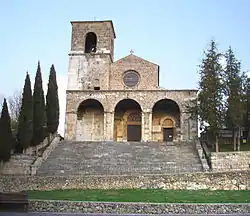Aquino, Italy
Aquino is a town and comune in the province of Frosinone, in the Lazio region of Italy, 12 kilometres (7 mi) northwest of Cassino.
Aquino | |
|---|---|
| Comune di Aquino | |
 Church of Santa Maria della Libera | |
 Coat of arms | |
Location of Aquino 
| |
 Aquino Location of Aquino in Italy  Aquino Aquino (Lazio) | |
| Coordinates: 41°30′N 13°42′E | |
| Country | Italy |
| Region | Lazio |
| Province | Frosinone (FR) |
| Government | |
| • Mayor | Libero Mazzaroppi |
| Area | |
| • Total | 19 km2 (7 sq mi) |
| Elevation | 106 m (348 ft) |
| Population (28 February 2017)[2] | |
| • Total | 5,342 |
| • Density | 280/km2 (730/sq mi) |
| Demonym(s) | Aquinati |
| Time zone | UTC+1 (CET) |
| • Summer (DST) | UTC+2 (CEST) |
| Postal code | 03031 |
| Dialing code | 0776 |
| Patron saint | Saints Thomas Aquinas and Constantius of Aquino |
| Saint day | March 7 and September 1 |
| Website | Official website |
The name comes from the Latin Aquinum, probably from aqua, meaning "water" as witnessed by the abundance of water that still crosses the territory today including many small springs.
History
The town was founded by the Volsci, who successfully defended it against Samnite invasions.
After the Roman conquest in the 4th century BC, Aquinum became an important commercial and production centre situated on the ancient Via Latina. In 211 BC it was given the title of urbs, previously the prerogative of Rome alone. In 125 BC the nearby town of Fregellae was destroyed and Aquinum grew to become the most important nucleus between Rome and Capua.
Aquinum was a municipium in the time of Cicero, and made a colonia during the Triumvirate.[3]
Aquinum is thought to be the birthplace of the poet Juvenal, and also of emperor Pescennius Niger.
The diocese of Aquinum was established c. 450. The patron saint of Aquino is St. Constantius of Aquino (San Costanzo), a 6th-century bishop.[4] After the death of bishop Jovinus, in c. 593, the seat remained vacant.
The county of Aquino within the Norman kingdom of Sicily was established in the 12th century. St. Thomas Aquinas, OP was born in 1225 in the castle of Roccasecca, 8 kilometres (5 mi) north of Aquino, to a collateral branch of the family of the counts of Aquino.
Main sights
One of the gates through which the Via Latina passed, now called Porta San Lorenzo, is still well preserved, and there are remains within the walls (portions of which, built of large blocks of limestone, still remain) of two (so called) temples, a basilica and an amphitheatre.[3]
Outside, on the south is a well-preserved 1st century BC triumphal arch with composite capitals, known as Arco di Marcantonio, and close to it the basilica of Santa Maria Libera, a 9th-century building in the Romanesque style erected over the remains of an ancient temple of Hercules Liberator, now roofless. Several Roman inscriptions are built into it, and many others that have been found indicate the ancient importance of the place, which, though it does not appear in early history, is vouched for by Cicero and Strabo.[3][5]
References
- "Superficie di Comuni Province e Regioni italiane al 9 ottobre 2011". Istat. Retrieved 16 March 2019.
- "Popolazione Residente al 1° Gennaio 2018". Istat. Retrieved 16 March 2019.
-
 One or more of the preceding sentences incorporates text from a publication now in the public domain: Ashby, Thomas (1911). "Aquino". In Chisholm, Hugh (ed.). Encyclopædia Britannica. 2 (11th ed.). Cambridge University Press. p. 252.
One or more of the preceding sentences incorporates text from a publication now in the public domain: Ashby, Thomas (1911). "Aquino". In Chisholm, Hugh (ed.). Encyclopædia Britannica. 2 (11th ed.). Cambridge University Press. p. 252. - He is distinct from St. Constantius of Perugia.
- According to H. Nissen, Ital. Landeskunde (Berlin, 1902), ii. 665, a road ran from here to Minturnae; but no traces of it are to be seen.
External links